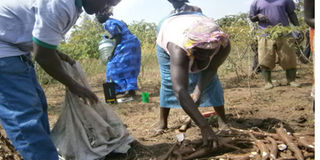New cassava variety to lift West Nile farmers off the poverty hook

An official from NARO helps a farmer to pack some of the sweet cassava in a sack in Arua District recently. photo by FELIX WAROM OKELLO
A farmer, Lillian Likico started growing cassava 30 years ago. To date, she remains one of the revered cassava growers in West Nile with vast experience.
But Likico says she has been growing bitter cassava mainly for home consumption for food (Enyasa).
She was constrained from growing the sweet cassava due to the limited access to stems and the shortage of land to grow it for commercial purpose.
“Cassava is our staple food here but I have been growing it for home consumption. When NARO selected me as one of the farmers for trials for the new variety of sweet cassava, I offered land.
And I have reaped from the one-year trial. We are grateful to God for the new technologies because our traditional crop called Omoo is hated because it is bitter,” she said as she smiled in her garden.
She has been earning about Shs1m from cassava sales from her one acre land. She said weeding the new cassava varieties of Narocas 1, Tajirica, Orera, Nkumba F10 and KBH 200-26 is easy and it is done only thrice.
About 30 farmers of Ambala Clan in Eruba Parish in Vurra County in Arua District were selected for the trials of the new varieties of cassava that was harvested after one year.
Another farmer, Jemilly Driwaru, says: “Our local variety, Omoo does not give much yield like these new ones. I will now need to rent more acres of land and plant because there is ready market for sweet cassava. This will relieve me and many farmers from poverty other than relying on the old variety.”
National Agricultural Research Organisation through National Crops Resources Research Institute (Naccri) carried out the trials on the new varieties.
Goal
Dr Titus Alicai, the principal research officer at Naccri, says: “Our aim is to have cassava that is resistant to pests and diseases and the ones that produces high yields to enable our rural farmers come out of poverty. They have also adapted crop variety that is able to meet the increasing population.”
Composition
Dr Alicai says the new varieties of Narocas 1 especially are resistant to pests and diseases like cassava mosaic that has ravaged many farms.
He said this has caused food insecurity and farmers suffered high poverty levels because they depended heavily on cassava.
In order to guard against duplication of the seeds of the new varieties through biotechnology, there are plans by ministry of Agriculture to establish cassava seed system where farmers will buy materials from certified fields. Naro has already trained 15 cassava seed producers where their fields are inspected with 170 acres of seeds.
Food and Agricultural Organisation says that farmers can benefit from cassava with its products of making flour, animal feeds, making of glucose, bakery products and confectioneries.
Cassava grows well in areas that receive just 400 mm of average annual rainfall. But much higher yields can be obtained with higher levels of water supply though irrigation technology that has remained rare here.




